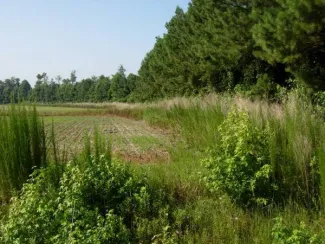What is edge? Within the context of wildlife habitat management, the term can get a bit complex. On a macro scale, one general definition of edge refers to the juncture of two different cover types, like where grassland meets forest. It is the transitional zone between the two habitats. However, on a more micro scale, edge can also refer to structural differences within a cover type. For example, within a native mixed-grass prairie, large patches of switchgrass scattered across the prairie create an edge effect. Possibly even consider individual bunchgrass clumps respective to the bare ground between them. Though the definition of edge requires qualifiers, the concept of edge and the practice of edge management remains important for wildlife habitat management in its entirety.

Field-forest border with a fallow border.
Since the concept can become so encompassing, edge habitat and the need for management may be more effectively contemplated while also considering the animal species associated with the system. Considering the animal in question, one can then determine, whether ‘x’ type of edge habitat is beneficial or not for ‘y’ animal. For instance, species like deer, rabbits and turkey all make use of a brush-scattered edge between a forest and a prairie where the edge consists of greenbrier, plums, sumac. In this case, this brushy edge would be used for escape and thermal cover, forage, nesting, bedding, etc. Raptors and some species of declining songbirds also benefit from this type of edge where they can perch for hunting or calling. On the other hand, species like lesser prairie-chickens that require large acreages of contiguous native prairie would not benefit from this type of brushy transition to a forest.
Edge habitat management would also apply to a pond. Consider the various fish and wildlife that habit a pond and how they make use of the edge. Submerged vegetation like coontail vs the open water provides escape cover for minnows and fry; Emerged, moist soil vegetation that grows along the shoreline of a pond like cattail, water willow (sp. Justicia), and smart weed (sp. Polygonum) provides forage and nesting for waterfowl and cover for reptiles and amphibians.
A landowner’s approach to edge management can and should be tailored to fit what is appropriate for the native plant community structure of the area and the habitat needs of the target wildlife species. And though the concept may be complex, the practices a landowner can implement to accomplish these objectives are quite straight forward.
If you have forest edges, create stretches of feathered edge scattered along forest boundaries by thinning the timbered edge and allowing brush and shrubs to regrow. If you have crop fields or non-native hay fields, plant or leave native grass and forb buffers around the field edges. Around ponds and wetlands, aside from clearing or spraying small areas to allow for human access, leave the majority of emerged and submerged aquatic vegetation. In native prairie or shrublands, plant or leave 30-foot-by-30-foot thickets widely scattered across these habitats. Then, in all these cases, maintain the edges that you created using prescribed fire or other practices so as not to allow the edges to overgrow, losing their functionality and beneficial qualities.